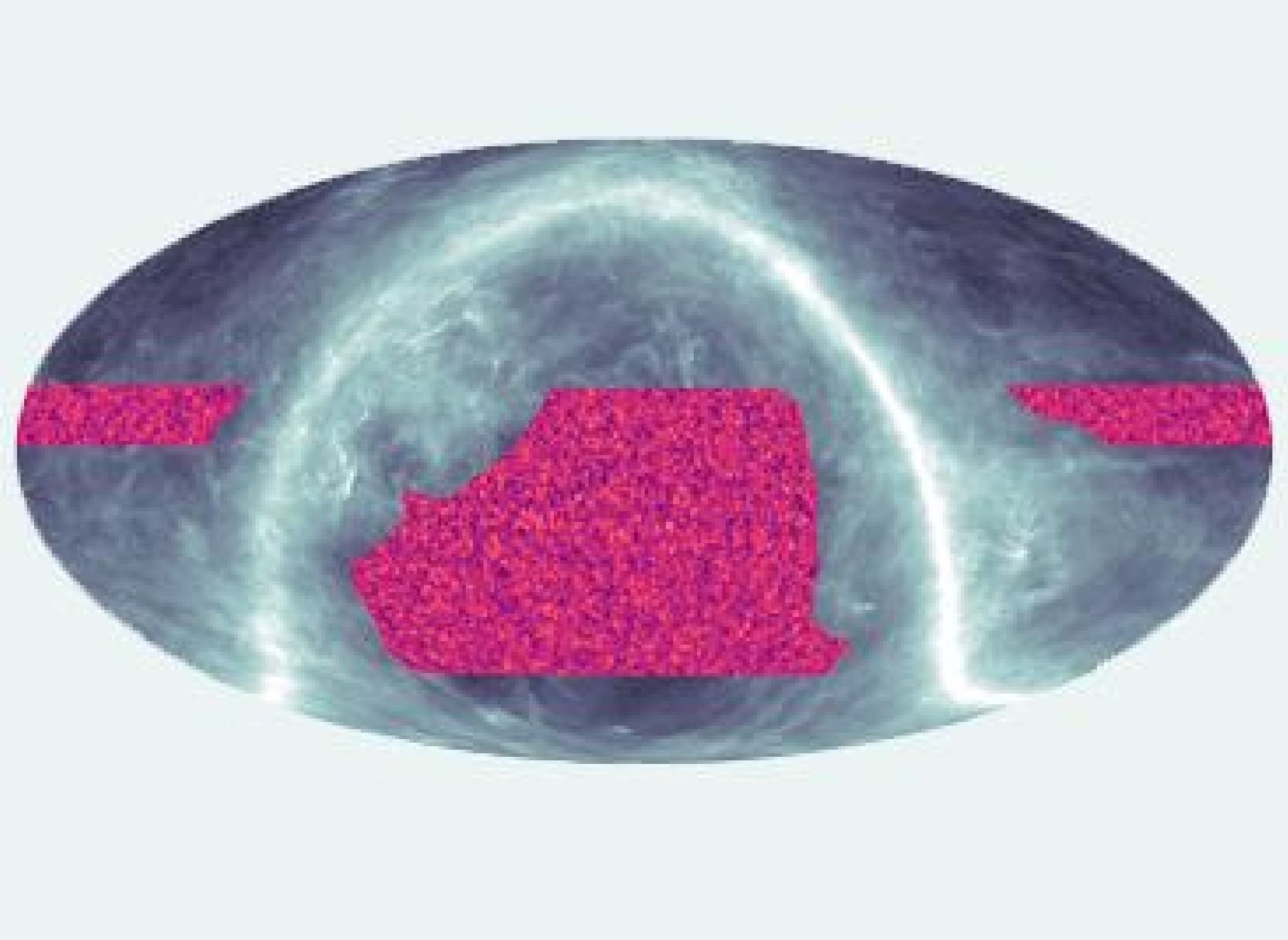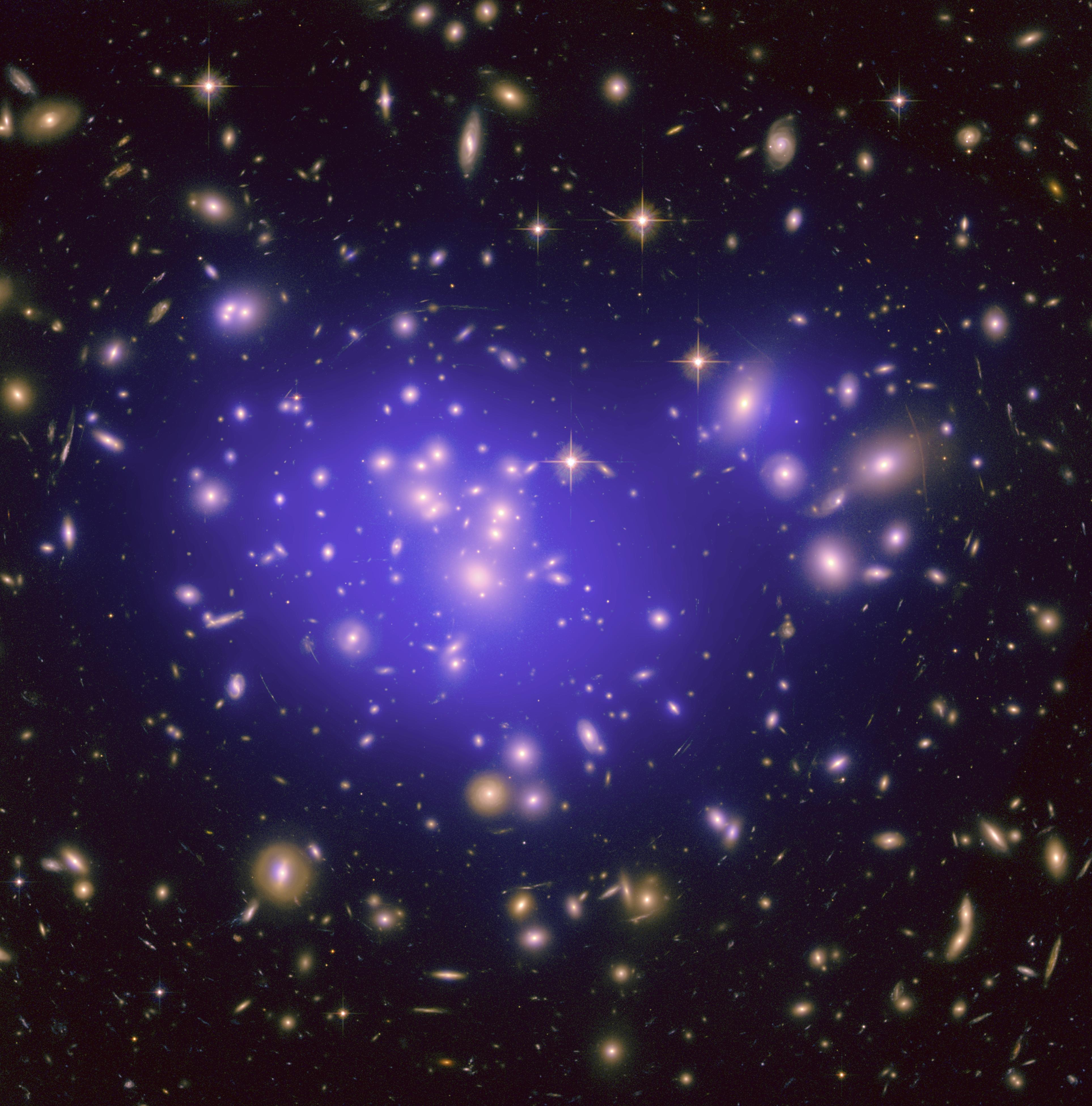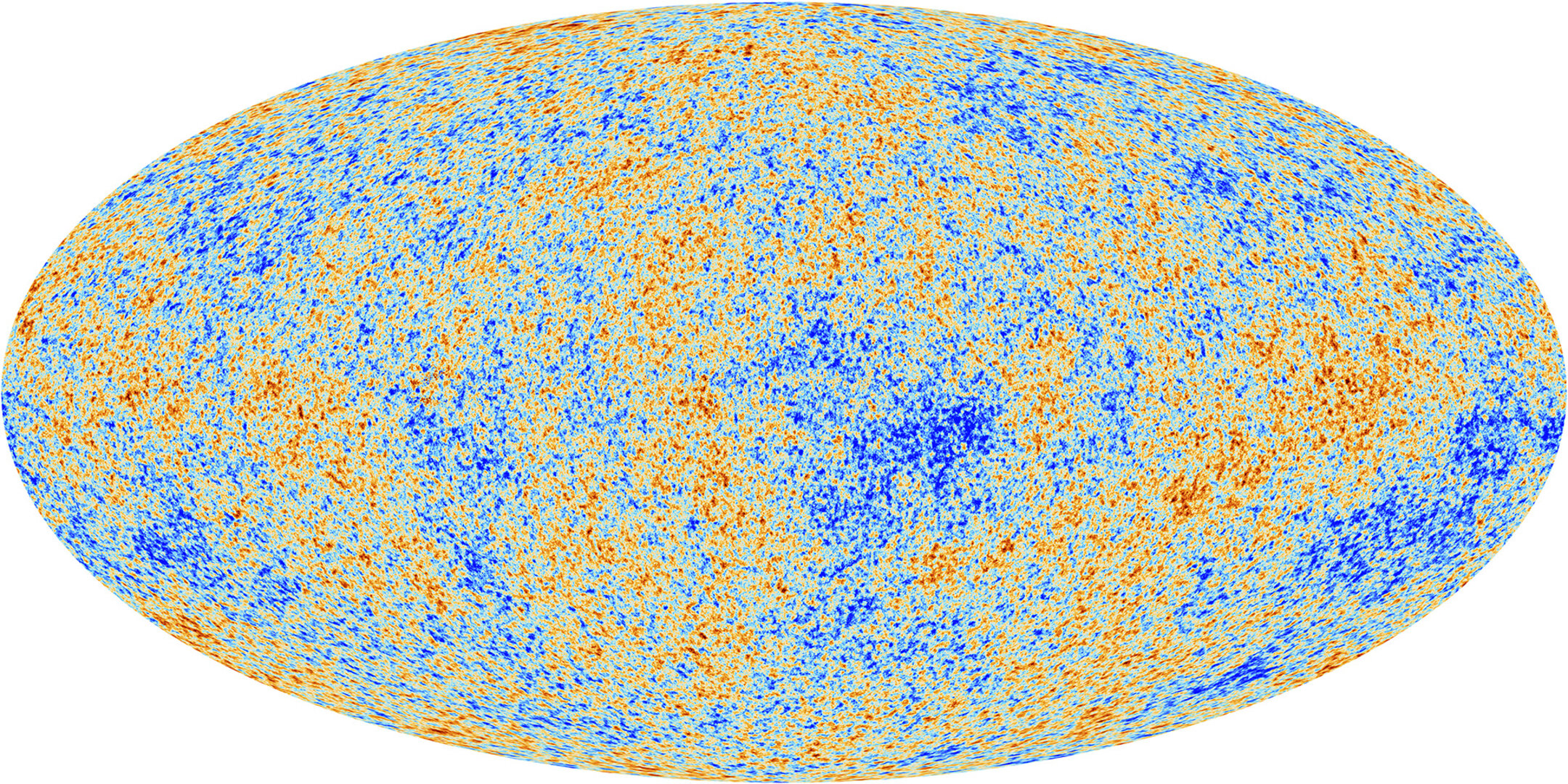If dark matter is 'invisible,' how do we know it exists?
Despite making up most of the matter in the universe, dark matter doesn't interact with light. So how do astronomers know it is there?

In April 2023, scientists from the Atacama Cosmology Telescope (ACT) collaboration created a map of the universe showing the detailed distribution of dark matter, a mysterious form of matter that makes up around 85% of the total matter in the universe.
While creating any accurate map of matter distribution across the cosmos is an impressive feat, it is particularly extraordinary for dark matter, which does not interact with light and thus cannot be seen directly with telescopes or other instruments.
So, if dark matter is effectively "invisible," how can scientists map it? And how do we even know dark matter exists? Put simply, to detect dark matter, astronomers look at its indirect effects on gravity and how it impacts other objects with mass and light.
Related: Latest dark matter news
All galaxies are believed to be wrapped in an invisible halo of dark matter, and this envelope is vitally important; galaxies are rotating so rapidly, that without dark matter, they would have been torn apart long ago if they were held together only by the influence of their stars, gas, dust and planets, according to the European Organization for Nuclear Research (CERN). As such, this mysterious substance must have played an important role in the evolution of the universe.
What makes dark matter "invisible"?
Everything we see around us on a day-to-day basis is made up of "ordinary" matter, known as baryonic matter, meaning it's composed of baryons (such as protons and neutrons). According to the Swinburne Centre for Astrophysics and Supercomputing, cosmic objects made of baryonic matter include clouds of cold gas, planets, comets and asteroids, stars, neutron stars and even black holes.
Most of these cosmic objects (as well as Earthbound objects, such as tables, cars and cats) can be seen because baryons interact with the electromagnetic force, one of the universe's four fundamental forces. When electromagnetic radiation, including visible light, falls on baryonic objects, they absorb photons and reemit them, or simply reflect them, so these objects can be seen. Even dark clouds of cosmic gas that do not shine brightly absorb photons of light at certain wavelengths, so they can be seen by their interaction with light.
Breaking space news, the latest updates on rocket launches, skywatching events and more!
Scientists know that dark matter is distinct from ordinary baryonic matter because whatever particles dark matter comprises either don't reflect, absorb or emit electromagnetic radiation or if they do interact with light, they do so incredibly weakly. This means dark matter can't be seen in traditional ways that rely on electromagnetic radiation.
Related: How does astronomy use the electromagnetic spectrum?
How do scientists know dark matter is there?
Although dark matter does not interact strongly via electromagnetism, it does interact with another fundamental force: gravity. It is through the interaction with gravity that astronomers were first able to discover dark matter and, later, accurately map it.
The first hints of dark matter were observed in 1933 when California Institute of Technology astronomer Fritz Zwicky used the Mount Wilson Observatory to measure the visible mass of the Coma Cluster of galaxies. Zwicky, later dubbed "the father of dark matter," found that single galaxies in this cluster were moving too fast for the cluster to remain together based on the gravity of the visible matter alone.
Zwicky suggested that an as-yet-unobserved type of mass — "dunkle Materie," or "dark matter" — might explain this disparity, but the concept wouldn't be widely accepted for decades to come, until after his death in 1974.
While studying the rotational dynamics of galaxies, Carnegie Institution astronomer Vera Rubin became the next scientist to infer the presence of dark matter with observations that helped to cement it as an accepted element of the universe. Rubin saw that the stars at the edge of spiral galaxies far from their dense centers were moving as fast as stars closer to the galactic heart, according to the American Museum of Natural History.
This was odd, as the visible mass of these galaxies shouldn't have enough gravitational influence to keep stars moving rapidly in sparsely populated outer regions in place. This meant that there had to be a huge amount of invisible matter in the outer regions of galaxies away from dense stellar populations. Rubin calculated that visible matter in the galaxies she observed must account for just 10% of their mass, and when revisiting Zwicky's findings from around four decades before, she discovered that a similar ratio of seen and unseen matter binds the Coma Cluster.
Since the 1970s and Rubin's discovery, astronomers have been using the gravitational influence of dark matter on the very fabric of space to better infer the location of dark matter. They theorize that filaments of dark matter link clumps of this mysterious substance, forming a vast cosmic web containing clusters of galaxies.
Mapping dark matter with a little help from Einstein
To map dark matter, astronomers use Albert Einstein's 1915 theory of general relativity, which states that gravity arises from objects with mass shaping the very fabric of time and space. This phenomenon affects the objects in space, energy and even light. As theoretical physicist John Wheeler once famously and succinctly said about general relativity, "Space-time tells matter how to move; matter tells space-time how to curve."
To understand the effect of mass on space, it may be helpful to look to a commonly cited analogy. Imagine placing objects of various masses on a stretched rubber sheet. The more mass one of these objects has, the more it warps the sheet. That means very massive cosmic objects, like galaxies, have considerable effects on the fabric of space.
Astronomers can measure this effect — and thus the mass of an object and how matter is distributed through it — using light that passes through this warped space. Light always travels in a straight line, but massive objects can cause the warping the space the path of light traveling through it is bent and is thus distorted. This phenomenon, known as gravitational lensing, is useful for detecting very faint objects, such as distant galaxies. It also allows astronomers to map dark matter, which has mass and, therefore, warps space-time and can indirectly affect the passage of light. By looking at how galaxies and galactic clusters cause light to bend, astronomers can calculate the mass of visible matter and its effect on this process and then estimate the amount of dark matter and how it is distributed.
Mapping dark matter with a cosmic fossil
The dark matter map created by the ACT collaboration covers a quarter of the sky visible over Earth and extends deep into the universe. To create this model and show the large-scale distribution of dark matter, the team needed to look at distortions in the cosmic microwave background (CMB). The CMB is the oldest form of light in the universe, created during an event called "the last scattering", which occurred around 380,000 years after the Big Bang. At this time, the universe was hot and dense, but as it expanded and cooled, it reached a temperature at which electrons could bind to protons to form the first atoms.
Until this point, electrons had been endlessly scattering photons. This meant light couldn't travel, so the universe was opaque. With free electrons snatched up and bound to protons, light could finally travel freely, and the universe instantly became transparent.
Because this first light was emitted when the universe was a fraction of its current size, it fills the universe with an extremely high degree of uniformity. Therefore, by looking at distortions in this first light caused by gravitational lensing, ACT scientists could measure the distribution of dark matter.
In addition to fitting the picture of the universe and dark matter suggested by general relativity and the standard model of cosmology, these highly accurate measurements could lead to a deeper understanding of dark matter.
Mapping dark matter FAQs answered by an expert
We asked Renée Hložek, an associate professor at the Dunlap Institute for Astronomy & Astrophysics at the University of Toronto and a contributing member at the Atacama Cosmology Telescope collaboration, some questions about the mapping of dark matter.

Renée Hložek is an associate professor at the Dunlap Institute for Astronomy & Astrophysics at the University of Toronto and a contributing member of the Atacama Cosmology Telescope collaboration.
What makes dark matter effectively "invisible"?
Dark matter is effectively invisible because it is "weakly interacting" with light. One of the ways we "'see" matter is if it makes its own light (like the sun) and if light bounces off its surface (as it does off your skin). The fact that dark matter is weakly interacting with light means that this process occurs only very, very rarely (or maybe not at all!), so it appears effectively "invisible" to us when looking with light. Searching for signs of dark matter is one of the biggest research areas in modern cosmology.
If dark matter doesn't interact with light, how do we know it's there?
The amazing thing is that matter interacts in other ways not related to light. It interacts gravitationally (just as you and I, and the sun, etc. do). This gravitational interaction means that it bends/curves the space around it as predicted by Einstein's theory of general relativity. To use the analogy of the sun, the sun is a massive object, and it bends the space around it. The Earth moves in that space around the sun in an orbit on a "geodesic" in this space. If you replaced the normal matter of the sun with dark matter, you wouldn't see any light from the sun, but Earth's orbit would continue unchanged!
Why is the gravitational influence of dark matter important?
The reason why this gravitational influence of dark matter is so cool is that we can exploit this fact to "'see" it in the sky. When a massive object distorts the space around it through its gravitational interaction, it means that objects will travel on geodesics in that curved space around the object. Just as the Earth's path is "bent" into an orbit, light will also be bent by the massive object. That means we can use the bending of light to detect the presence of dark matter with mass that isn't shining like "normal" matter.
This bending of light is actually one of the ways that Einstein's theory was first tested in the early 20th century. During the 1919 solar eclipse, when the normal shining light of the sun was blocked by the moon, the projected positions of stars close to the sun on the sky were recorded and they were slightly shifted because the light from those stars was being bent by the sun.
How can we use this to "map" dark matter?
In our case, the ACT collaboration is measuring the very small bending or deflections of light that originated a few hundred thousand years after the Big Bang, from a time we call "recombination," because the protons and electrons in the universe recombined to be neutral atoms. We call this light the cosmic microwave background, or CMB. The dark matter in the universe between us and that time of recombination very slightly bends, or "lenses," the CMB light. It's a really subtle effect, and so our team has developed sophisticated tools to measure the lensing deflection signal of the CMB light and use it to infer, or "see," the integrated dark matter.
What have we learned about the universe by creating these dark matter maps?
Partly, we confirm that there must be something massive bending the light of the CMB — which may sound like "We confirmed it is there," but it's actually more profound. Some folks don't like dark matter as a concept and try to explain other pieces of evidence for dark matter (like the rotation curves of galaxies) by suggesting that perhaps light itself is behaving differently in those systems. But seeing this map of the dark matter we infer from its lensing signal makes those arguments for light behaving weirdly much harder to swallow. It is a beautiful prediction of general relativity, and to see it mapped across the sky is breathtaking! This same theory (general relativity) makes predictions for how the universe will change in the future, and so any adjustments to this theory or the parameters within it that we can make through observations is key to understanding the eventual fate of the universe — or, as I like to think of it, how this movie is going to end.
Additional resources
Vera Rubin is considered the "mother of dark matter." Read about her work to uncover this mysterious form of matter on this page from the American Museum of Natural History. The cosmic microwave background was integral to this latest map of dark matter. Read more about the CMB from these resources from the European Space Agency.
Bibliography
American Museum of Natural History. (2000). Vera Rubin and dark matter. In Soter, S. & deGrasse Tyson, N. (Eds.), Cosmic horizons: Astronomy at the cutting edge. New Press.
https://www.amnh.org/learn-teach/curriculum-collections/cosmic-horizons-book/vera-rubin-dark-matter
CERN. (n.d.). Dark matter. Retrieved April 28, 2023, from https://home.cern/science/physics/dark-matter
Clavin, W. (2020, October 23). Where is dark matter hiding? Caltech Magazine. https://magazine.caltech.edu/post/where-is-dark-matter-hiding
De Swart, J. (2019, September 3). Deciphering dark matter: The remarkable life of Fritz Zwicky. Nature. https://www.nature.com/articles/d41586-019-02603-7
Overduin, J. (2007, November). Einstein's spacetime. Gravity Probe B: Testing Einstein's Universe. Stanford University. https://einstein.stanford.edu/SPACETIME/spacetime2.html
Swinburne University. (n.d.). Baryonic matter. Cosmos: The SAO Encyclopedia of Astronomy. Retrieved April 28, 2023, from https://astronomy.swin.edu.au/cosmos/b/Baryonic+Matter
U.S. Department of Energy. (n.d.). DOE explains … dark matter. Retrieved April 28, 2023, from https://www.energy.gov/science/doe-explainsdark-matter

Robert Lea is a science journalist in the U.K. whose articles have been published in Physics World, New Scientist, Astronomy Magazine, All About Space, Newsweek and ZME Science. He also writes about science communication for Elsevier and the European Journal of Physics. Rob holds a bachelor of science degree in physics and astronomy from the U.K.’s Open University. Follow him on Twitter @sciencef1rst.


